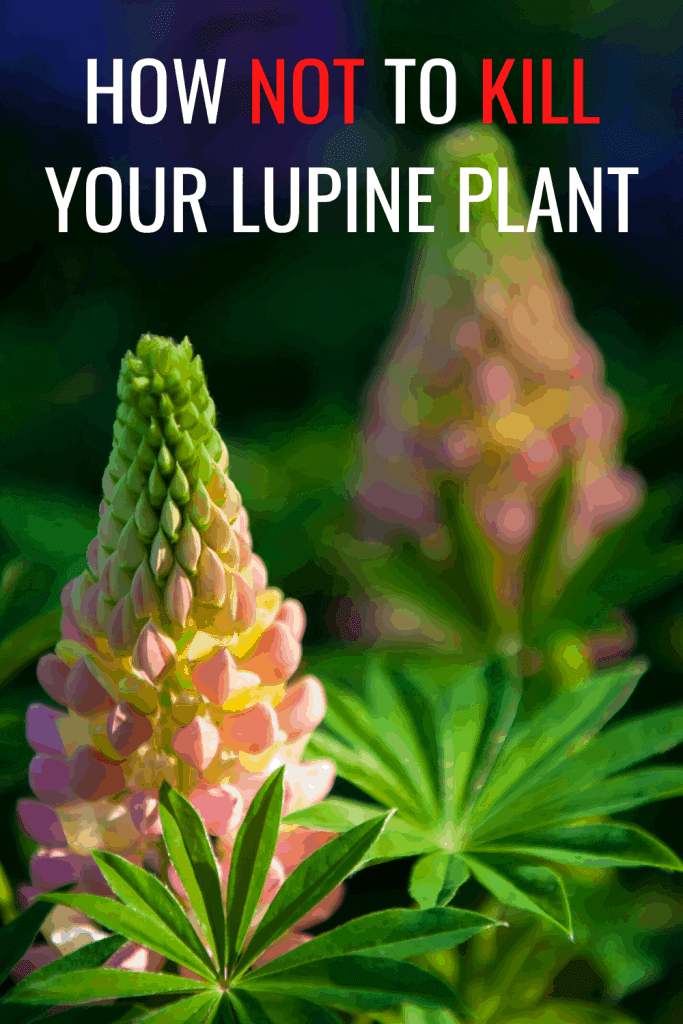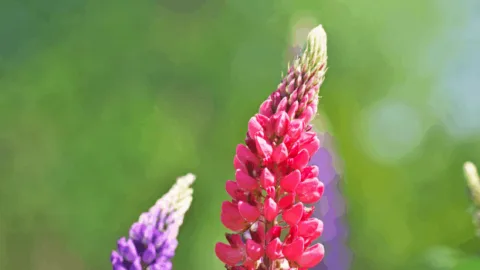Wildflowers have always had their own appeal. Many choose them because of their floral fragrances, their bright hues, or even the rustic appeal that they add. The Lupine plant, or Lupinus spp, is a perennial shrub that can add all of these aspects to your home. Typically kept in the garden, the Lupine plant can also be placed in pots. Table of Contents

LUPINE PLANT BASIC CARE
Lupinus is a great houseplant to add to your collection for a number of reasons. They don’t take up too much space, add a touch of desert flair, and aren’t all that picky in terms of their needs. To help you out, you’ll want to know about the different aspects of basic care involved with the Lupine plant. We’ve touched on these below!
SOIL
These types of plant develop from one single large root, called a taproot. Because of this, they can be a little sensitive when it comes to the soil that they require, as well as being sensitive to handling. One of the key aspects to think of is how well the soil can drain.
They are susceptible to root rot. In general, you may want to choose a mixture that is slightly acidic. Options include sand soil types.
Rich loam and clay are what you should avoid! These soils don’t allow the water to be drained from the pot, forcing your plant to sit in water for too long.
LIGHT
One of the main reasons why people are drawn to Lupine plants is because of their flashy flowers. Light is a large contributor to obtaining such poppy blooms!
Their preference tends to shift towards full sun, but this can change depending on the year or even where you live.
Colder climates require that you place your Lupine plant in a spot that gets amble sunlight. If it’s on the warmer end where you live, opt for filtered sunshine.
Finding the right amount of light may take a few tries. If you’re not too heartbroken about the occurrence of less vibrant flowers, decide on a place that has partial shade.
These conditions won’t entirely deplete the act of any blooms, so there’s no need to worry if you’d rather play it safe.
WATERING
In their natural habitat, Lupinus are a fan of environments that are fairly damp, or that have seasonally moist soils. These habitats include wetlands, damp forests, and meadows.
Although they prefer a near constant supply of liquid, they can handle when portions of the year are unusually dry.
The indoor variety is about the same in terms of their watering needs. They demand to have a soil that is able to drain properly, yet that doesn’t mean that want to be dry. The consensus is that they want about an inch of water for in a week.
We suggest watering them once every three or four days. Ideally, the soil should be kept somewhat moist. Forget to water your Lupine? Don’t worry. They are drought tolerant, as long as it doesn’t go on too long.
TEMPERATURE
Lupine plants need to have a certain temperature met in order for it to develop properly from a young plant.
This process is known as germination. In reality, they can handle a wide range of temperatures.
You only need to make sure that the room doesn’t get too hot, or too cold. Extremes are when the plant can’t grow.
The lower end of the spectrum should be 0 degrees Celsius. They also can’t handle anything over 30 degrees Celsius.
This should be relatively easy for an indoor plant!
HUMIDITY
You may recall us say earlier that these plants like to be kept in places that are moist. That does not, however, extend to humidity.
They won’t necessarily stop growing if your house is particularly humid, but they prefer that it isn’t.
You can take a few precautions to avoid placing them in the wrong spot. Certain rooms, such as the living room and bedroom tend to have lower levels of humidity.
Your Lupine plant may also enjoy being placed next to a cracked window. Airflow helps to reduce overall humidity.
FERTILIZER
In order to keep those blooms bold and beautiful, you may want to consider investing in fertilizer. It’s not entirely necessary, but you may prefer the results with added food.
If you do want to help them out, buy fertilizers that are rich in phosphorus instead of nitrogen.
Also, adding too much fertilizer can be worse than not any at all. So, make sure to do your research first!
PROPAGATION
There are a number of houseplants that are considered relatively easy to propagate. The Lupine plant isn’t necessarily an outlier from this group, but they do have some challenges.
Remember the taproot that we were talking about earlier? Because of how it’s designed, it can be privy to breaking upon rough handling.
Basal cuttings are the easiest – and safest – method! You can also go about making a new individual through division, but this can be somewhat tricky.
GROWTH
These floras are known for being able to become deeply rooted, when given the right circumstances. Fortunately, they don’t spread out like other plants that you might have in your household.
This makes them quite content with the pot that you place them in as long as it is deep enough.
Those grown indoors typically reach a height between 1 and 3 feet, while garden varieties tend to average at about 3 to 8 feet in overall height. As we said earlier, they aren’t all that wide, only spreading out by a foot or two.
POTTING
A common place for Lupine plants tends to be in the backyard with other wildflowers, though you can choose to keep them inside. Transferring these individuals can actually be quite tricky.
They might look sturdy, but those taproot systems are easy to damage if you handle them too roughly.
Potted floras don’t need to be repotted all too frequently. This generally needs to be done every two to three years. When you do, be mindful of how you handle the roots.

WATERING YOUR LUPINE PLANT
Figuring out how much water to give your Lupinus isn’t all that straightforward. Finding the happy medium between moist soil that isn’t overly saturated can be a pain for some.
The first trick to making sure that they don’t get root rot is to provide ample drainage on the bottom of your pot.
The next tip we’d give anyone with a Lupine plant is to check the soil on a regular basis. The top two inches of soil should be damp, not waterlogged.
The quantity of water should also depend on the time of year, as well as the development.
Younger plants will need more frequent watering sessions. You’ll want to add enough water to fully saturate down to the roots.
This can be as often as every day. Older individuals will require more water in the summer and spring months. You do not need to give your plant as much water in the winter.
LUPINE PLANT PROPAGATION METHODS
Lupins can be grown from seedlings, but this isn’t as common despite what you would think. Although more straightforward, seedlings won’t allow you to know which color the plant will be.
If you’re fine with any vibrant hue, go for it! Another technique, division, is a bit risky due to the sensitive root system.
We suggest propagating these plants through a process known as basal cuttings. Don’t know what that is? Follow the steps we’ve provided below!
PROPAGATION THROUGH BASAL CUTTINGS
- Choose to propagate your Lupinus in the spring months where new growth is more likely to develop in a healthy manner.
- Look over your plant and find the spot where you’ll make your incision. This will be down at the base of the plant where the crown and the stem meet up.
- Using clean, sharp scissors, make a cut that is close to the crown.
- You’ll only need one or two stems. If they have a lot of foliage, trim them back.
- Plant these stem cuttings into a container with freshly laid soil.
- Water the individual, and place them in a room that is fairly warm.
- Keep checking back every few weeks for new roots to develop. Once this happens, transfer them to a new pot and continue to care for them!
LUPINE PLANTS: PESKY INVADERS
Being a fairly popular yard dweller, the Lupine plant is at risk for being thwarted by bugs and other pests. You might think that keeping these individuals indoors will fix this problem entirely. Unfortunately, this isn’t the case.
Bugs and diseases can still encroach upon your Lupinus through an open window, the soil that you bought at the store, or even from other plants in your home. Here are the most common pests.
As far as insect infestation, you are most likely to come across aphids and a bug called the blister beetle. Less frequent indoor culprits include snails and slugs. Their main goal is to feed off of the leaves until the plant is dead. Aphids and blister beetles can be taken care of through the average dish soap. Mix this with water and simply spray along the leaves.
If this doesn’t do the trick, there are insecticides that will completely wipe them out!
We have an article all about aphid removal and prevention, for those who are curious!
The real problem that Lupine owners have is when diseases present themselves. There are a number of conditions that can attack your plant.
These include brown spot, cucumber mosaic virus, stem rot, oedema, powdery mildew, and anthracnose. Aphids spread some of these diseases, while others attack the root system when you have given your flora too much water.
Discolorations of the leaves as well as dying foliage are typical signs of such diseases. Fungicides can be quite handy, but we suggest looking into what your plant has before dealing with it.
LUPINE PLANT PROBLEMS
Watching your plant on a daily basis can save you from problems later down the road. Sure, they might not be able to tell you what’s wrong, but they’ll leave signs through the coloration of their foliage, and overall state.
PROBLEM #1: YELLOWING FOLIAGE
These plants are extremely sensitive to how much water you give them. Spotting yellow discoloration on the leaves can be a sign that the water content is too high, or that the pH levels are too much.
Begin by adjusting your watering schedule. Allow the plant to dry out more before giving it more water. If this doesn’t work, consider investing in a soil that is more basic.
Are you still curious about this phenomenon? Read our article on yellowing leaves.
PROBLEM #2: DROOPY PLANT
Typically, a droopy plant is never a happy one. This can indicate that your Lupinus is getting too much water, or that it has become rootbound.
It might be better to see if it’s a watering issue first as transferring these individuals can be costly. Scale back on the amount of water and then consider carefully transferring it to a new container that is larger.
PROBLEM #3: LEAVES TURNING BROWN
Brown leaves aren’t actually all that uncommon for these floras. If you notice a white, dust-like substance on the leaves prior to them shifting to brown, then it could be a sign of powdery mildew.
In the case of such a disease, you’ll want to rinse off your plant with a gentle hose. For harder cases, invest in fungicide.
PROBLEM #4: THE CURLING OF LEAVES
The foliage of Lupinus is supposed to be standing tall, not curling to the side. In case this happens, it’s safe to assume that you have an infestation of bugs.
Removal of such pests is top priority! This can be done through gently spraying the leaves with soapy water, hosing it down, or through the use of insecticide.
THE 5 TOP TIPS FOR A HAPPY LUPINE PLANT
Lupinus makes for a great addition to the home. They’re fragrant, brightly colored, and add a wildflower appeal. Just like most indoor plants, you’ll want to make sure that their needs are met. Forget what you should focus on. Read our little cheat sheet!
- The more sun the better, as long as they can get some shade later on in the day!
- Opt for a soil that is loose, light, and able to drain properly.
- Make sure to keep the soil evenly saturated without causing the plant to sit in water for too long. This can lead to root rot.
- Although not necessary, you can give your Lupinus a boost through the use of a nitrogen-rich fertilizer. Just be sure to dilute it and don’t overdo it!
- Be on the lookout for any of the diseases that can affect your plant and take action immediately through a fungicide or soapy water mixture.
LUPINE PLANT FAQ
Are Lupines annual or perennial?
Most perennial plants are known for coming back over and over. The Lupine plant is an outlier, being classified as a “short-lived” perennial. You can expect them to last anywhere from two to five years.
Where do Lupines grow?
You can either grow these plants in the safety of your home, or out in the backyard. Those in the home should be placed in a warm room with quite a bit of sunshine.
Do Lupine flowers spread?
One of the nice aspects about these plants is that they aren’t known for spreading out. This includes the blooms. They tend to grow upward rather than take up too much space width-wise.

Daniel has been a plant enthusiast for over 20 years. He owns hundreds of houseplants and prepares for the chili growing seasons yearly with great anticipation. His favorite plants are plant species in the Araceae family, such as Monstera, Philodendron, and Anthurium. He also loves gardening and is growing hot peppers, tomatoes, and many more vegetables.


